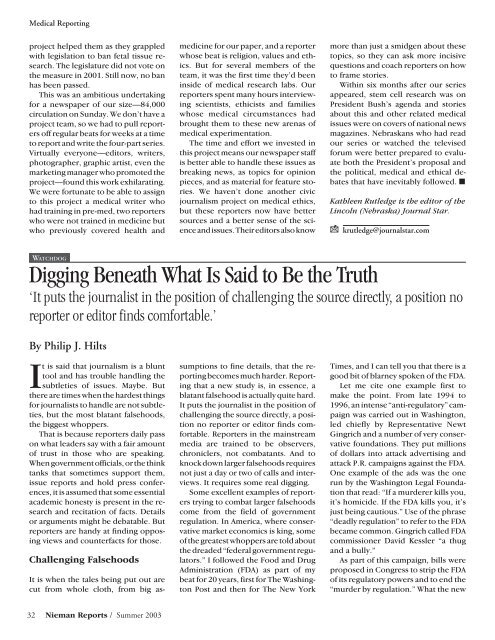summer-2003-Part 2-live - Nieman Foundation - Harvard University
summer-2003-Part 2-live - Nieman Foundation - Harvard University
summer-2003-Part 2-live - Nieman Foundation - Harvard University
- No tags were found...
Create successful ePaper yourself
Turn your PDF publications into a flip-book with our unique Google optimized e-Paper software.
Medical Reportingproject helped them as they grappledwith legislation to ban fetal tissue research.The legislature did not vote onthe measure in 2001. Still now, no banhas been passed.This was an ambitious undertakingfor a newspaper of our size—84,000circulation on Sunday. We don’t have aproject team, so we had to pull reportersoff regular beats for weeks at a timeto report and write the four-part series.Virtually everyone—editors, writers,photographer, graphic artist, even themarketing manager who promoted theproject—found this work exhilarating.We were fortunate to be able to assignto this project a medical writer whohad training in pre-med, two reporterswho were not trained in medicine butwho previously covered health andmedicine for our paper, and a reporterwhose beat is religion, values and ethics.But for several members of theteam, it was the first time they’d beeninside of medical research labs. Ourreporters spent many hours interviewingscientists, ethicists and familieswhose medical circumstances hadbrought them to these new arenas ofmedical experimentation.The time and effort we invested inthis project means our newspaper staffis better able to handle these issues asbreaking news, as topics for opinionpieces, and as material for feature stories.We haven’t done another civicjournalism project on medical ethics,but these reporters now have bettersources and a better sense of the scienceand issues. Their editors also knowmore than just a smidgen about thesetopics, so they can ask more incisivequestions and coach reporters on howto frame stories.Within six months after our seriesappeared, stem cell research was onPresident Bush’s agenda and storiesabout this and other related medicalissues were on covers of national newsmagazines. Nebraskans who had readour series or watched the televisedforum were better prepared to evaluateboth the President’s proposal andthe political, medical and ethical debatesthat have inevitably followed. ■Kathleen Rutledge is the editor of theLincoln (Nebraska) Journal Star.krutledge@journalstar.comWATCHDOGDigging Beneath What Is Said to Be the Truth‘It puts the journalist in the position of challenging the source directly, a position noreporter or editor finds comfortable.’By Philip J. HiltsIt is said that journalism is a blunttool and has trouble handling thesubtleties of issues. Maybe. Butthere are times when the hardest thingsfor journalists to handle are not subtleties,but the most blatant falsehoods,the biggest whoppers.That is because reporters daily passon what leaders say with a fair amountof trust in those who are speaking.When government officials, or the thinktanks that sometimes support them,issue reports and hold press conferences,it is assumed that some essentialacademic honesty is present in the researchand recitation of facts. Detailsor arguments might be debatable. Butreporters are handy at finding opposingviews and counterfacts for those.Challenging FalsehoodsIt is when the tales being put out arecut from whole cloth, from big as-sumptions to fine details, that the reportingbecomes much harder. Reportingthat a new study is, in essence, ablatant falsehood is actually quite hard.It puts the journalist in the position ofchallenging the source directly, a positionno reporter or editor finds comfortable.Reporters in the mainstreammedia are trained to be observers,chroniclers, not combatants. And toknock down larger falsehoods requiresnot just a day or two of calls and interviews.It requires some real digging.Some excellent examples of reporterstrying to combat larger falsehoodscome from the field of governmentregulation. In America, where conservativemarket economics is king, someof the greatest whoppers are told aboutthe dreaded “federal government regulators.”I followed the Food and DrugAdministration (FDA) as part of mybeat for 20 years, first for The WashingtonPost and then for The New YorkTimes, and I can tell you that there is agood bit of blarney spoken of the FDA.Let me cite one example first tomake the point. From late 1994 to1996, an intense “anti-regulatory” campaignwas carried out in Washington,led chiefly by Representative NewtGingrich and a number of very conservativefoundations. They put millionsof dollars into attack advertising andattack P.R. campaigns against the FDA.One example of the ads was the onerun by the Washington Legal <strong>Foundation</strong>that read: “If a murderer kills you,it’s homicide. If the FDA kills you, it’sjust being cautious.” Use of the phrase“deadly regulation” to refer to the FDAbecame common. Gingrich called FDAcommissioner David Kessler “a thugand a bully.”As part of this campaign, bills wereproposed in Congress to strip the FDAof its regulatory powers and to end the“murder by regulation.” What the new32 <strong>Nieman</strong> Reports / Summer <strong>2003</strong>
















